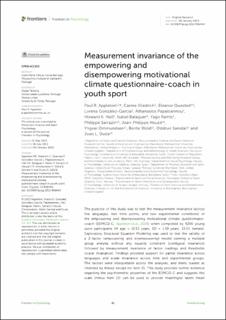Measurement invariance of the empowering and disempowering motivational climate questionnaire-coach in youth sport
Appleton, Paul R.; Viladrich, Carme; Quested, Eleanor; González-García, Lorena; Papaionnaou, Athanasios; Balaguer, Isabel; Ramis, Yago; Sarazzin, Philippe; Ommundsen, Yngvar; Wold, Bente; Samdal, Oddrun; Hall, Howard K.; Heuzé, Jean-Philippe; Duda, Joan L.
Peer reviewed, Journal article
Published version
Permanent lenke
https://hdl.handle.net/11250/3066482Utgivelsesdato
2023Metadata
Vis full innførselSamlinger
- Artikler / Articles [2119]
- Publikasjoner fra Cristin [1107]
Sammendrag
The purpose of this study was to test the measurement invariance (across five languages, two time points, and two experimental conditions) of the empowering and disempowering motivational climate questionnaire-coach (EDMCQ-C; Appleton et al., 2016) when completed by 9256 young sport participants (M age = 11.53 years, SD = 1.39 years; 13.5% female). Exploratory Structural Equation Modeling was used to test the validity of a 2-factor (empowering and disempowering) model running a multiple group analysis without any equality constraint (configural invariance) followed by measurement invariance of factor loadings and thresholds (scalar invariance). Findings provided support for partial invariance across languages and scalar invariance across time and experimental groups. The factors were interpretable across the analyses, and items loaded as intended by theory except for item 15. This study provides further evidence regarding the psychometric properties of the EDMCQ-C and suggests this scale (minus item 15) can be used to provide meaningful latent mean comparisons (Marsh et al., 2013) of empowering and disempowering coach-created climates across athletes speaking the five targeted languages, across time, and across experimental groups.
Beskrivelse
This is an open-access article distributed under the terms of the Creative Commons Attribution License (CC BY). The use, distribution or reproduction in other forums is permitted, provided the original author(s) and the copyright owner(s) are credited and that the original publication in this journal is cited, in accordance with accepted academic practice. No use, distribution or reproduction is permitted which does not comply with these terms.
